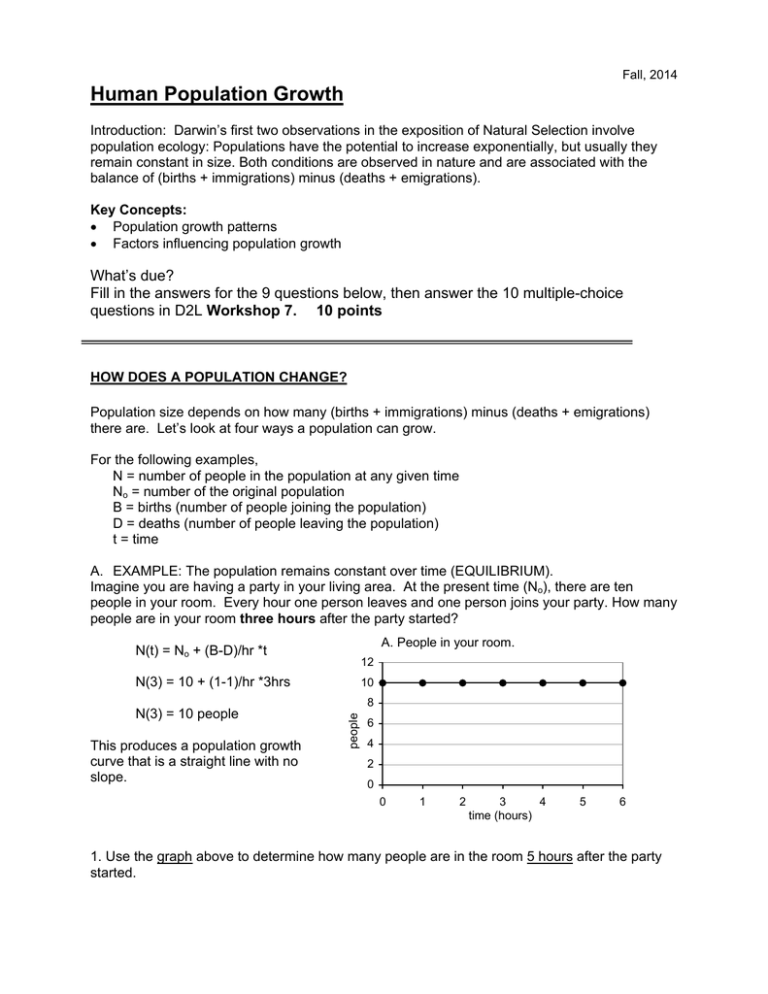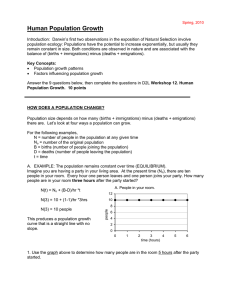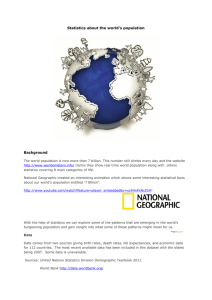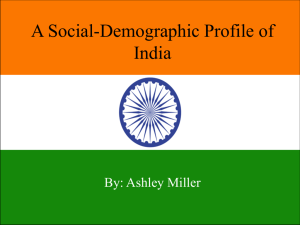Human Population Growth
advertisement

Fall, 2014 Human Population Growth Introduction: Darwin’s first two observations in the exposition of Natural Selection involve population ecology: Populations have the potential to increase exponentially, but usually they remain constant in size. Both conditions are observed in nature and are associated with the balance of (births + immigrations) minus (deaths + emigrations). Key Concepts: Population growth patterns Factors influencing population growth What’s due? Fill in the answers for the 9 questions below, then answer the 10 multiple-choice questions in D2L Workshop 7. 10 points HOW DOES A POPULATION CHANGE? Population size depends on how many (births + immigrations) minus (deaths + emigrations) there are. Let’s look at four ways a population can grow. For the following examples, N = number of people in the population at any given time No = number of the original population B = births (number of people joining the population) D = deaths (number of people leaving the population) t = time A. EXAMPLE: The population remains constant over time (EQUILIBRIUM). Imagine you are having a party in your living area. At the present time (No), there are ten people in your room. Every hour one person leaves and one person joins your party. How many people are in your room three hours after the party started? A. People in your room. N(t) = No + (B-D)/hr *t 12 N(3) = 10 + (1-1)/hr *3hrs This produces a population growth curve that is a straight line with no slope. 8 people N(3) = 10 people 10 6 4 2 0 0 1 2 3 4 time (hours) 5 6 1. Use the graph above to determine how many people are in the room 5 hours after the party started. B. EXAMPLE: The population changes at a constant rate over time. Same room – different party. At the beginning of the party (No), there are ten people at your party. Every hour eight more people join and six leave -- a gain of two people per hour. How many people are partying three hours later? B. Friday night's attendance 25 20 N(3) = 10 + (8-6)/hr *3hrs N(3) = 10+ (2*3) = 16 people people N(t) = No + (B-D)/hr *t 15 10 5 This produces a population growth curve that is a straight line with a positive slope. 0 0 1 2 3 4 time (hours) 5 6 Use the graph to determine how many people are in the room 5 hours after the party started. 2. Use the equation above to calculate the number of party-goers in the room 5 hours after the party started. Does your calculation agree with the graph? C. EXAMPLE: The population changes at an exponential rate over time. This is the rate of population growth when there are no limitations on resources (food, land, etc.). The variable are the same as in the two previous examples, but the equation is different. N(t) = No ert (“initial population times, e to the [r times t]“) N(t)= number of people in the population at any given time No = number of the original population r = rate of increase of the population t = time e is the base of the natural logarithm 3. Look up the current world population today ___ billion in the World Population Page. Write it down. 4. Look up the current world population growth rate in the CIA Fact Book select: World, select: People – Birth rate: Write it down. (Note: if a percent is shown (e.g. 1.092%), divide by 100 to get the actual yearly rate "r”) HUMAN GLOBAL POPULATION: FUTURE POPULATION: The world rate of population increase is not constant either in time or space! It can be positive or negative. It is calculated as the rate of (Births + Immigrations) - (Deaths + Emigrations) in the population. For the calculations below, assume that "Births" include both births and immigrations and that "Deaths" include both deaths and emigrations. 5. What will the population of Ukraine be in 100 years? Using the CIA World Fact Book calculate (N(t) = No ert) the population of Ukraine 10 years from now. (search bar: select UKRAINE / People and Society :: UKRAINE / Population growth rate) Copy the needed values into the table below and use the exponential population growth equation N(t) = No ert (If you don't have a scientific calculator, you can find one online at http://web2.0calc.com/) (Multiply r (the growth rate) times 100 years, click [ex], multiply that result times the current population). Current Population No ____ Births/1000 = _____ per thousand Deaths/1000 = _____ per thousand Growth rate (Births minus Deaths) _____ % r = rate of increase _____ (NOT PERCENT) Population in 100 years ____________ 6. What will be the global population in 10 years? Use the exponential equation N(t) = No ert and the data you looked up in questions 3 & 4 to determine the global population size in 10 years. (If you don't have a scientific calculator, you can find one online at http://www.calculator.com/ ) (Multiply r (q. 4) times 10 years, click [ex], multiply that result times the population (q. 3).) Current Population No ____ (question 3) Growth rate r = rate of increase _____ (question 4) Population in 10 years ____________ (in billions) 7. GEOGRAPHICAL DIFFERENCES IN GROWTH RATES. Visit the CIA World Fact Book click on "World," "People" and then “People and Society :: World.”. Fill out the table below for the five countries with the greatest populations. First write down the Country & Population, then find the growth rate for each country. Country 1 2 3 4 5 Population birth rate% death rate % population growth rate % Based on the table above: Enter the name and population of the world’s most populous country _____ _____ Which country has the highest population growth rate and what is that rate? _____ _____ Based on current trends, which country will be largest in 100 years? Which country has the highest birth rate and what is its % education expenditure? _____ _____ _____ (note that China does not report education expenditure) 8. GROWTH RATES DURING THE LAST 50 YEARS. Visit the U.S. Census World Population Page ; click on [DATA] (tool bar top of page), click on “International Data Base (IDB);” click on “World Population” In what year did the world growth rate reach its highest value? ___ (click on “World Population Growth Rates: 1950-2050” write it down) What was the world growth rate in that year? ___ (write it down) From the same graph (World Population Growth Rates: 1950-2050) find the current world growth rate? ___ This current world growth rate is approximately ___ percent of the maximum rate 9. “r” or “K” FOR THE WORLD? From the World Population Page click on “World Population: 1950-2050” Which of these curves most is closest to the shape of the " World Population: 1950-2050?"







